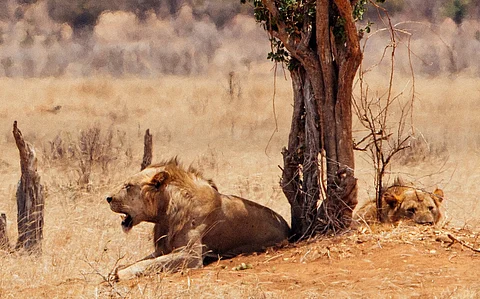

The two male lions that wrought havoc and terror during the construction of the Ugandan Railway between the Kenyan port of Mombasa and the East African interior from March-December 1898, feasted on the bodies of railway construction workers as well as local African wildlife, a new study has found.
The two lions’ reign of terror ended when Lt Col John Henry Patterson, a British Army engineer in charge of the project, killed them. The two lions may have killed anywhere between 28 and 35 local African as well as Indian workers, who had been brought by the British from the subcontinent to help construct the railway line. Other estimates which say the lions killed as many as 135 people, have largely been rejected by researchers as ‘exaggerated’.
The taxidermied remains of the lions can today be seen at Chicago’s Field Museum of Natural History (FMNH). They were sold to the FMNH by Patterson in 1925.
Over the years, various hypotheses have been presented as to why the lions, both maneless, turned to hunting, killing and eating humans.
A theory posited for the lions of the Tsavo region being maneless is the extreme heat in the area. Another theory is the thorny foliage of Tsavo.
One hypothesis for the human killing by the Tsavo lions is that the 1890 African rinderpest epidemic decimated their natural prey. Yet another theory is that the site where the Ugandan Railway was constructing a bridge over the Tsavo river and which was the site of most of the lion attacks had also been a part of the slave trade carried out by Arabs from the Sahara to the Red Sea and Indian Ocean. Many sick slaves that were left behind by caravans usually fell prey to lions of the region, who subsequently had developed a taste for human flesh.
The lions’ dentition could also have caused them to turn on humans. In 2017, Vanderbilt University came out with research that blamed the lions’ dental problems for their hunting people.
“The Tsavo lion that did the most man eating, as established through chemical analysis of the lions’ bones and fur in a previous study, had severe dental disease. It had a root-tip abscess in one of its canines—a painful infection at the root of the tooth that would have made normal hunting impossible,” the study said.
In the 1990s, Thomas Gnoske, a co-author of the study, had found that thousands of broken and compacted hairs had accumulated in exposed cavities in the lions’ damaged teeth during their lifetimes.
In the new study, Gnoske and other scientists conducted an analysis of four individual hairs and three clumps of hairs extracted from the lions’ teeth.
The other scientists included Ogeto Mwebi, senior research scientist at the National Museums of Kenya; Nduhiu Gitahi, a researcher at the University of Nairobi; University of Illinois postdoctoral researcher Alida de Flamingh and anthropology professor Ripan S Malhi, also from the same University.
The results of the analysis of hair DNA revealed that the Tsavo lions also ate giraffe, oryx, waterbuck, wildebeest, and plains zebra, besides humans. Interestingly, the giraffe eaten by the lions belong to the Masai (Giraffa tippelskirchi tippelskirchi) subspecies typically found in southeast Kenya, which are now endangered.
The researchers also found lion hair inside the cavities. They concluded that it was due to the lions grooming themselves that lion hair eventually surfaced in the cavities.
“Lion hair in the tooth cavities could result from self-grooming or allogrooming (grooming each other) between these two lions that are known to have formed a coalition or, alternatively, because of cannibalism. However, while intraspecific killing (e.g., infanticide) is common in lions, cannibalism is rare,” the study noted.
Human hairs were also found in the cavities. However, the researchers refrained from using the information to predict ancestry and linked ethnicities of the person to whom the hair belonged.
The reason, they said, was because this “would require discussions with local institutions and groups about the project as well as reporting the detailed human colonial history of this geographic region, which is beyond the scope of this current study”.